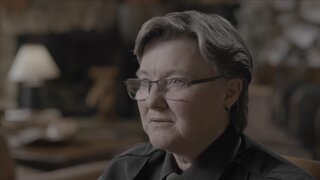Create a free profile to get unlimited access to exclusive videos, breaking news, sweepstakes, and more!
Orange Sock Connects 2 Colorado Women Abducted and Shot During 1982 Blizzard
Advances in DNA evidence was key to finally closing the brutal 40-year-old double homicide.
On the frigid, snow-driven night of January 6, 1982, law enforcement in the ski town of Breckenridge, Colorado, got a report from local resident Jeffrey Oberholtzer that his 29-year-old wife Barbara “Bobbie Jo” was missing.
She worked as a receptionist and had gone out to celebrate a job promotion. She planned to return home by hitching a ride, something she did regularly. But this time, she never made it.
The next morning, the couple’s friends who’d formed asearch party found Bobbie Jo’s body in the snow off of a highway.
“Her body was essentially frozen,” Deputy District Attorney Stephanie Miller told Buried in the Backyard on Oxygen.
Bobbie Jo Oberholtzer shot twice
She had been shot. There was blood on her and on the snow. There was a zip tie on one of her wrists.
“As soon as I saw that, I said ‘This is no accident.’ The victim was murdered,” said Jim Hardtke, a retired agent with the Colorado Bureau of Investigation (CBI).
RELATED: Missing Brooklyn Boxer Found 4 Years Later Buried In New Jersey With a Broken Neck
January 6 turned out to be a very busy night for welfare checks by local police called to help people stuck in vehicles on the side of the road. In one situation, a plane flying overhead saw somebody flashing an SOS signal with their headlights in the area of Guanella Pass. The individual was found and was subsequently rescued, according to Det. Wendy Kipple, Park County Sheriff’s office.
Meanwhile, clues began to emerge in the investigation. Jeffrey Oberholtzer got a call from a rancher who lived miles from his home and claimed to have found Bobbie Jo’s license in his driveway.
On the drive to collect it, Oberholtzer spotted his wife’s blue backpack on the roadside. Near the knapsack he found a bloody Kleenex and wool glove, according to Kipple. He collected them and gave them to police, who determined that the blood on the items matched Bobbie Jo’s.
A coroner determined that Bobbie Jo had been shot twice in the chest. There were no signs of a sexual assault. The bullet was so damaged that ballistics matching would be difficult, investigators said.
A heavy key ring found near Bobbie Jo’s body belonged to her, according to her husband. But an orange sock nearby wasn’t hers.
Orange Sock at Crime Scene a Mystery
The presence of the stray orange bootie sock at the crime scene was a mystery, according to Charles McCormick, a lead investigator on the case task force.
Jeffrey Oberholtzer became an early suspect and denied any wrongdoing, according to Hardtke. And then the case took a turn.
“By January 9, I learned that there was another hitchhiker reported missing to the Summit County Sheriff's Office,” Hardtke said. “Her name was Annette Schnee.”
Annette Schnee Found Fatally Shot
Schnee, 22, hoped to become a stewardess, according to family members. In the meantime, she was working two jobs in Frisco, Colorado — one during the day at the Holiday Inn and another in the evening as a waitress at a local bar. She was reported missing when she failed to show up for work.
“She didn’t have a car so she would hitchhike,” said Kipple. She was last seen in the early evening on Jan. 6 while hitchhiking south of Breckenridge.
Similarities between the two women who vanished on the same night were striking. “Annette and Bobbie Jo both work in the Breckenridge area,” said Hardtke. “They both hitchhike. They’re both young and attractive.”
Were the cases connected? When police questioned Jeffrey Oberholtzer, he said he recalled giving Schnee a ride months earlier and handing her one of his appliance shop business cards.
That coincidence seemed suspicious to officials, who asked Oberholtzer to take a polygraph test. He did, and he passed.
Six weeks after Bobbie Jo’s murder and Schnee’s disappearance, there was a violent sexually oriented attack on a woman in the same general area of Summit County. She accepted a ride from a man who beat her with a hammer and raped her.
Tom Luther was arrested for the crime but he denied any involvement in the other cases. “Luther had a violent history, especially against women,” said Deputy District Attorney Mark Hurlburt. “Law enforcement thought they had their guy.”
But officials had no direct evidence linking Luther with Bobbie Jo or Schnee. Luther was convicted of the sexual assault and sentenced to ten years in prison.
With no leads on other suspects, investigators kept circling back to Jeffrey Oberholtzer. As he maintained his innocence, Schnee’s family members grieved their loss.
On July 3, 1982, a 13-year-old boy found Schnee’s body floating in Sacramento Creek — some 10 miles the other side of Hoosier Pass from Breckenridge, according to McCormack. She'd been shot in the back.
During Schnee’s autopsy, she was found to be wearing one long purple sock and one orange bootie sock, like the one found near Bobbie Jo’s crime scene. Schnee’s sisters confirmed that their mother had given the orange socks to her.
Sock links victims, but the cases go cold for decades
“Finding the mate to that orange sock just invigorated the entire investigation,” said Hardtke. Investigators believed that Schnee had been picked up first on Jan. 6 and was murdered that same day.
“The orange sock becomes significant because when Annette got out of this vehicle, she didn’t put on one of those orange socks,” said Miller. “She left it in the vehicle.”
Detectives theorized that the sock was in the car when the killer later picked up Bobbie Jo. When Bobbie Jo got out of the vehicle, she dragged the orange sock out onto the ground before she was shot.
Jeffrey Oberholtzer’s business card was found in Schnee’s jacket pocket. He was given a second polygraph exam, this one by the CBI. Once again, he passed, detectives said.
The case went cold. In 1989, McCormack became involved in the case. A task force was established. Detectives thought they’d caught a break and found a link between the women’s cases and an armed carjacker. The lead went nowhere.
RELATED: Alleged North Pole Serial Killer Strangled and Shot 4 Young Women and 1 Girl
In 1995, detectives circled back to reconsider Tom Luther’s role in the deaths of Schnee and Bobbie Jo. That was a dead end.
The role of DNA testing became key to cracking the case. “In the 90s, DNA advanced from the late 80s at an incredible pace,” said Mitch Morrisey, owner of United Data Connect, a company specializing in genealogy testing.
In 1988, the crime lab tested Bobbie Jo’s bloody glove and found that the DNA profile was a mixture. The blood was Bobby Jo’s and an unknown male.
Jeffrey Oberholtzer’s DNA was not a match to the evidence. He was finally cleared as a suspect.
In 2002, the profile was entered into CODIS but resulted in no match. Then, around 2020, Kipple and McCormack turned to genetic genealogy, which combines DNA analysis and genealogy.
Familial DNA leads to Alan Phillips as a suspect
That line of research eventually yielded the names of two brothers — one who lived in Arizona, the other who lived in Colorado. The local resident was Alan Phillips.
Detectives learned that Phillips was the man who had been rescued the night of Jan. 6, 1982 from Guanella Pass. The rescue made local news reports. A witness recalled that Phillips had a gash in his forehead. He said he struck his head in a fall. Investigators believe Bobbie Jo could have gouged him with her heavy key chain, according to Buried in the Backyard.
Phillips had spent a year and a half behind bars. He had been arrested in nearby Fairplay, Colorado in 1973 for assault and burglary. He’d picked up the victim when she was hitchhiking.
Investigators focused on getting a DNA sample from Phillips. On February 21, 2021, they covertly picked up a Sonic fast food bag he discarded. Phillips’ DNA matched the profile on the glove.
Phillips was charged with two counts of murder and kidnapping. The case was ironclad, investigators acknowledged. There was no murder weapon and the defense team could punch holes in the way evidence was collected.
On August 31, 2022, Phillips was convicted and sentenced to two consecutive life terms. After serving less than six months, Phillips, 72, committed suicide behind bars.
To learn more about the case, watch Buried in the Backyard on Oxygen.




































